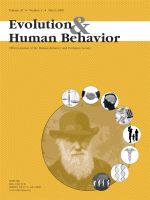[lang_pt]Li há uns tempos na revista Time um artigo sobre a ciência do romance que referia um conjunto de resultados científicos que procuram explicar os ritos do acasalamento na espécie humana. O artigo fazia referência a um trabalho científico publicado na revista «Evolution and Human Behavior» que resolvi agora procurar. Felizmente este trabalho, incluido na edição de Novembro de 2007, pode ser consultado gratuitamente.[/lang_pt]
[lang_en]Some time ago, I read a Time magazine article on the science of romance that referred to several scientific results seeking to explain the mating rituals of the human species. One of those was published in the journal of “Evolution and Human Behavior” that I now decided to look for. Fortunately this work, included in the November 2007 issue, is available for free.[/lang_en]
[lang_pt]É um trabalho fascinante. Os investigadores da Universidade do Novo México propuseram-se registar as gorjetas recebidas por dançarinas de «lap dancing» ao longo dos dias do seu ciclo menstrual. Como os autores assumem que os académicos estão pouco familiarizados com a sub-cultura dos clubes nocturnos para homens, começam por descrever o funcionamento dessas casas e a forma como as dançarinas aliciam os clientes a despenderem as gorjetas normalizadas de 10 dólares por uma «lap dance» na sala principal ou de 20 dólares no conforto da sala VIP.[/lang_pt]
[lang_en]It is a fascinating work. Researchers at the University of New Mexico proposed to register the tips received by lap dancers along the days of their menstrual cycle. As the authors assume that the scholars are unfamiliar with the gentleman’s club subculture, they begin by describing the operation of these clubs and what the dancers have to do to bring customers to spend the usual US$10 tip for lap dance in the main room or US$20 for the comfort of a VIP room.[/lang_en]
[lang_pt]Para este estudo foram recrutadas 18 dançarinas durante 60 dias, cobrindo um total de cerca de 5300 danças, em 296 turnos de trabalho diário com uma média de 5 horas. O ciclo hormonal da mulher foi dividido em 3 fases: a menstrual (dias 1 a 5), a fértil (dias 9 a 15) e a luteal (dias 18 a 28). Os resultados mostram que as dançarinas que não tomavam a pílula receberam em média 335 dólares por turno na fase fértil, 260 na fase luteal e 180 na menstrual. Nas dançarinas que tomavam a pílula não foi observada diferença significativa entre os rendimentos na fase fértil e na fase luteal. Estes resultados contrariam a visão de que o cio humano terá evoluído no sentido de se ter perdido ou escondido dos parceiros masculinos em consequência da organização social monogâmica que caracteriza a nossa espécie. Além disso, os resultados são particularmente relevantes por se basearem no valor económico atribuído pelos clientes das dançarinas.[/lang_pt]
[lang_en]For this study 18 dancers were recruited for 60 days, covering a total of 5300 dances, on 296 daily shifts lasting for an average of 5 hours. The woman’s hormonal cycle was divided into 3 phases: the menstrual phase (days 1 to 5), the fertile phase (days 9 to 15) and the luteal phase (days 18 to 28). The results show that the dancers that were not taking the pill received on average US$335 per shift in the fertile phase, 260 in the luteal phase and 180 in the menstrual phase. The dancers taking the pill had significant difference between the income in the fertile phase and the luteal phase. These results contradict the view that the human estrus have evolved to be lost or hidden from males as a result of the monogamous social organization that characterizes our species. Furthermore, these results are particularly relevant for being based on the economic value assigned by the customers.[/lang_en]
[lang_pt]Para além das diversas questões levantadas no artigo, colocou-se-me uma adicional: como é que se justificam as despesas de um estudo destes junto da entidade financiadora? Estou a imaginar a estupefacção dos auditores da Fundação para a Ciência e Tecnologia ao analisar a elegibilidade dos recibos dos pagamentos às dançarinas das casas de diversão nocturna. De qualquer forma uma coisa parece-me certa: não haveria dificuldade em encontrar bolseiros de investigação para trabalhar no projecto.[/lang_pt]
[lang_en]In addition to the various issues raised in the article, an additional got my attention: how to justify the costs of a such a study to the funding entity? I can imagine the astonishment of the auditors of the Portuguese Foundation for Science and Technology while examining the eligibility of the receipts of payment to gentleman’s club dancers. Anyway one thing seems certain to me: there would be no difficulty in finding research assistants to work in the project.[/lang_en]
[lang_pt][/lang_pt][lang_en][/lang_en]

 Português
Português
